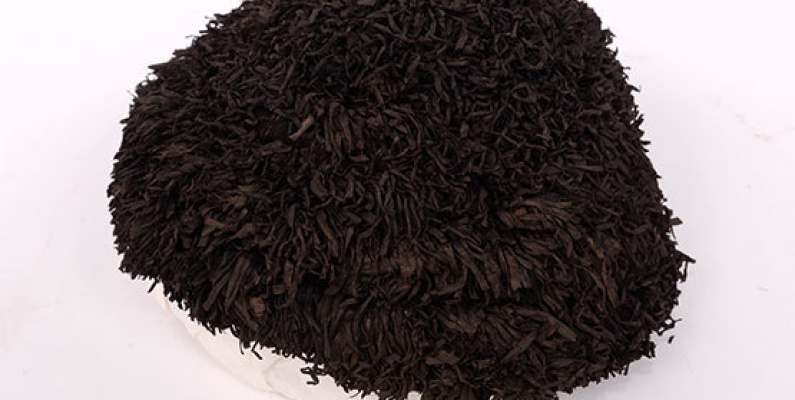
The proper use for the term potae taua refers specifically to mourning caps, and the hats worn by Māori women, and sometimes men, during periods of loss and grief, particularly the death of a spouse [1]. It is not a term heard often in conversation today, even for Māori and it has been a very long time since these special taonga were a part of living Māori culture. My first exposure to the term potae taua occurred as a child, when it featured in the karanga (call) of a kuia while I was attending a tangihanga (funeral), and when I later asked I was told of these distinctive symbols of grief worn by our ancestors.
The potae taua held within the Otago Museum collection is a specific type of potae taua known as a karapo, and is one of only a handful in New Zealand [2]. It is woven in the same way as a kakahu or traditional cloak, where a flax fibre foundation is carefully woven together from the centre in a spiral pattern. Tags of carefully prepared seaweed, or sometimes kuta (river reed), were scrapped, softened and woven into the twists of the weaving as it progressed, producing a cap with a ruffled appearance. This whole cap was then dyed using traditional methods, where iron rich mud is used to produce a deep black colour [3]. The weaving of a cap such as this was a lengthy process that would have taken several days.

Image: Portrait of unidentified Maori widow with moko kauae and wearing a potae taua. New Zealand. Tourism Department. NZ Government Tourist Department. Ref: PA2-1227. Alexander Turnbull Library, Wellington, New Zealand.
Potae taua are rarely seen today, and unfortunately few have survived to make it into a museum collection. They are by nature fragile, delicate items, and as they were deeply sentimental to their wearers many were likely buried with their owners. [4] Potae taua were also documented by early explorers; James Cook describes a kind of potae taua he observed when visiting Queen Charlotte Sound:
“The women in these canoes, and some of the men, had a head-dress which we had not before seen. It consisted of a bunch of black feathers, made up in a round form, and tied upon the top of the head, which it entirely covered, and made it twice as high, to appearance, as it was in reality.”
It was later revealed to Cook that the people he had observed had recently been in a battle where many people were killed, and the potae taua were worn to show their mourning for the casualties. [5]
Despite a lack of physical evidence, oral tradition and stories passed down by Māori support the use of potae taua by ancestors, and potae taua like the one held by the Otago Museum represent a significant connection to the past. [6]
[1] Wallace, E (2002). Traditional Maori dress : rediscovering forgotten elements of pre-1820 practice. (Doctoral). University of Canterbury, p. 111.
[2] Oppenheim, R (1973). Maori Death Customs. Wellington: A H and A W Reed, p. 55.
[3] Elsdon, B (1905). “Maori Eschatology: The Whare Potae (House of Mourning) and its Lore; being a Description of many Customs, Beliefs, Superstitions, Rites, &c., pertaining to Death and Burial among the Maori People, as also some Account of Native Belief in a Spiritual World.” Transactions And Proceedings Of The Royal Society Of New Zealand 1868-1961, 38, 179. Retrieved from http://rsnz.natlib.govt.nz/volume/rsnz_38.html.
[4] Wallace, E (2002). Traditional Maori dress : rediscovering forgotten elements of pre-1820 practice. (Doctoral). University of Canterbury, p. 111.
[5] Buck, P (2014). The coming of the Maori. [Wellington]: New Zealand Electronic Text Centre, p. 284.
[6] Wallace, E (2002). Traditional Maori dress : rediscovering forgotten elements of pre-1820 practice. (Doctoral). University of Canterbury, p. 111.
Top image: Potae taua. Otago Museum Collection. © Otago Museum.
